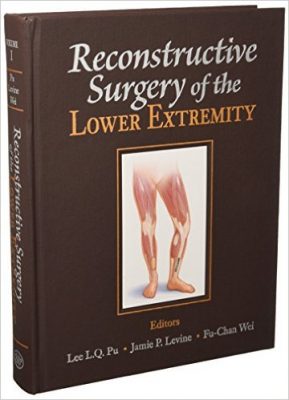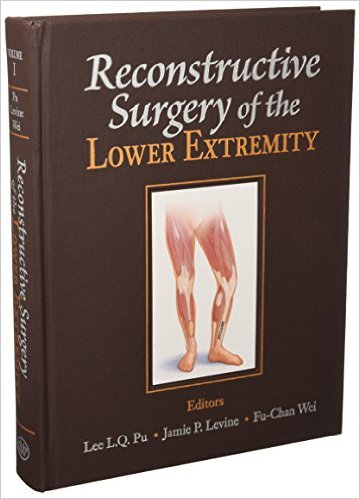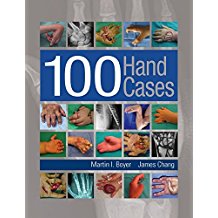 Editors: Lee L.Q. Pu, MD; Jamie P. Levine, MD; and Fu-Chan Wei, MD
Editors: Lee L.Q. Pu, MD; Jamie P. Levine, MD; and Fu-Chan Wei, MD
Publisher: Thieme – 1,368 pages, plus Index
Book Review by: Nano Khilnani
This two-volume book published in 2013 by Quality Medical Publishing in collaboration with Thieme is one of the most authoritative works in the relatively scarce literature on surgeries pertaining to the lower extremity, available on the market. Those two factors – authoritativeness and scarcity – make this text quite valuable.
This is the combined work of 119 specialists in lower-extremity surgery from all over the United States and six other countries: Austria, Germany, Italy, Scotland, Spain, and Taiwan. The authors of the 80 chapters of this extensive work teach and do surgeries of various kinds on different regions of the human anatomy. They are involved in, among others : endovascular, general, hand, foot, orthopedic, plastic, reconstructive, and vascular surgeries.
This book of nearly 1,370 pages has been organized into two volumes of two sections each, which we list below to give you – the student or practitioner – a broad overview:
- Volume One
- Section I – General Principles for Managing Lower Extremity Traumatic Injuries
- Section II – Soft Tissue Reconstruction of the Lower Extremity
- Subsection 1. Principles
- Subsection 2. Soft Tissue Flaps
- Volume Two
- Section III – Bone and Joint Reconstruction
- Subsection 1. Principles
- Section IV – Special Considerations in Lower Extremity Reconstruction
- Section III – Bone and Joint Reconstruction
In section I – volume I, you will find chapters that provide you, among other topics, an overview of lower extremity reconstruction; anatomy and pathophysiology: evaluation of complex traumatic injuries; modern imaging studies for preoperative evaluation; timing of reconstruction; management of soft tissue injuries, above-knee and below-knee orthopedic injuries;
Also: major nerve injuries and major vascular injuries; recipient vessels for lower-extremity reconstruction; arteriovenous loops in free-tissue transfer; perioperative management of soft tissue reconstruction; prosthetics; rehabilitation; psychosocial impact of lower extremity disfigurement; reoperation; and surgical outcomes of type III-B and type III-C tibial fractures.
In section II – volume I, there are chapters on: management of wounds with vacuum-assisted closure; the role of loco-regional flap and free tissue transfers; fascio-cutaneous versus muscle flap in soft tissue; the role of skin substitutes; endoscopally assisted harvest of free muscle flap; free latissimus dorsi flap; free serratus anterior flap; free thoracodoral artery perforator flap; free lateral thoracic artery perforator flap; free scapular and parascapular flap; rectus abdominis flap; free and local omental flaps;
Also: free radial forearm flap; free gracilis flap; free vastus lateralis flap; free and local anterolateral thigh flaps: the Asian experience; free and local anterolateral thigh flaps: the Western experience; gastrocnimius flap; soleus flap; tibialis anterior flap; peronus brevis flap; reversed sural artery flap; extensor digitorum flap; medial plantar flap; abductor digiti minimi flap; pedicled perforator flap; freestyle local and free perforator flap; free partial muscle flaps; and multiple flaps.
In section III – volume II, you will find chapters on: management of bony defects with controversial bone grafts, with vascularized bone grafts, and with bone transport; reconstruction of large bony defects: the use of massive allograft and bone morphogenic protein as bone graft substitutes; management of bony defects, with the combined use of vascularized bone flap and allograft; management of fracture non-unions, management of chronic osteomyelitis;
Also: fundamental principles of foot and ankle bony reconstruction; soft tissue management of the knee and ankle joint after arthroplasty; management of stress fracture following bony grafting; free vascularized fibula graft; free vascularized proximal fibula for epiphyseal transfer; free vascularized iliac graft; and free vascularized serratus anterior rib flap.
In section IV – volume II, there are chapters on: orthoplastic approach to composite tissue loss; lower limb functional reconstruction; local tissue transfer for functional reconstruction; adjunctive and secondary procedures for functional improvement; revascularization of the ischemic lower extremity; soft tissue management in complicated vascular surgery; soft tissue reconstruction after tumor resection; reconstruction of lower extremity burns; and soft tissue reconstruction of the foot and ankle.
Also: replantation of the lower extremity; reconstruction of congenital pseudo-arthrosis; reconstruction of the weight-bearing heel; reconstruction after amputation; reconstruction of lower extremity battle injuries; coverage of hardware; management of venous stasis disease; surgical correction of lymphederma; and management of vascular anomalies.
In addition to the above-listed contents of this book, a DVD provided in the inside back cover of volume has information on six more topics.
A review of chapter 6, Management of Soft Tissue Injuries, written by Lee L.Q. Pu and James P. Levine, laid out on pages 79 to 96, shows that there is a good balance of text and photos to enable the reader to learn and retain the basic principles of two important concepts discussed here: soft tissue reconstruction and the proper healing of wounds.
These are the topics and subtopics covered in this chapter following a short introduction:
- Wound Management Before Definitive Soft Tissue Reconstruction
- Selection of Appropriate Soft Tissue Reconstruction Options
- Skin Graft
- Local or Distant Flap
- Microvascular Free Tissue Transfe
- Muscle Flaps Versus Fasciocutaneous Flaps
- The Role of the Vacuum-Assisted Closure (VAC) Device
- The Role of Skin-Substitute Materials
- Recent Advances in Flap Reconstruction of the Lower Extremity
- Discussion
- Important Considerations (with five points laid out)
- References With Kay Annotations
Essentially, the authors point out (in the Discussion which is sort of a conclusion ) in this chapter that managing tissue injuries in the legs and other parts of the lower extremity is a challenging task for surgeons. But over the last two decades or so, it has become easier to get satisfactory results because 1. Free tissue transfer “is now performed as a common option for limb salvage,” and 2. “VAC therapy is used as a means for temporary wound closure and an effective intermediate step preceding definitive soft tissue reconstruction.”
The chapter authors also write that to achieve an ‘optimal outcome’ for a ‘complex lower extremity wound,’ there are many valid options available.
This is an excellent book on lower extremity surgery for several reasons: knowledgeable and experienced editors and authors; extensive in the range of subjects covered and intensive as well; and quite practical to use with good layout and organization.
Editors:
Lee L.Q. Pu, MD, PhD, FACS, FICS is Professor of Surgery in the Division of Plastic Surgery at the University of California – Davis, in Sacramento, California.
Jamie P. Levine, MD, FACS is Associate Professor of Plastic Surgery; Director of Microsurgery in the Department of Plastic Surgery at New York University Langone Medical Center; and Director of Plastic Surgery at Bellevue Hospital, in New York, New York.
Fu-Chan Wei, MD, FACS is Professor and Dean of the Department of Plastic Surgery at Chang Gang Memorial Hospital at Chang Gang University College of Medicine in Taipei, Taiwan.







